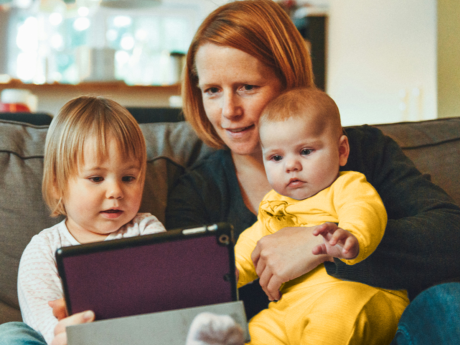- Debt relief starts here
- Who we are
-
-
Our locations
-
Debt Relief in Alberta
-
Debt relief in British Columbia
-
Debt relief in Manitoba
-
Debt relief in New Brunswick
-
Debt relief in Newfoundland and Labrador
-
Debt relief in Nova Scotia
-
Debt relief in Nunavut
-
Debt relief in the Northwest Territories
-
Debt relief in Ontario
-
Debt relief in Prince Edward Island
-
Debt relief in Saskatchewan
-
Debt relief in the Yukon
-
Family finance 101: A simple way to talk to your kids about money

It can be uncomfortable to talk about money. But, when it comes to effectively managing your family’s finances, communication is key. Many parents overlook the importance of holding family finance meetings because they think their kids are too young to talk about money, won't understand, or won't be interested—but that’s a myth.
We challenge you to hold a family finance meeting. The benefits—finding new budgeting strategies, ways to cut unnecessary expenses, reducing financial stress—are countless and the results might surprise you!
How to hold a family finance meeting
Before you gather as a family, you should think about how you’d like to structure your meeting and where you’d like to hold it. You could hold your meeting over a family meal, while eating your favourite snacks around the kitchen table, or in your pyjamas on the couch. You know your family best and understand what kind of setting would bring the most comfort and collaboration. The general agenda should revolve around what’s most important to your family, whether that’s upcoming vacations, expense cutbacks, or large purchases to budget for.
Three steps to prepare for your next family meeting
Step 1: Schedule your meeting. Find a time that works for your entire family and stick to it. Whether it's written on the calendar, a note on the fridge, or shared in your family group chat, make sure your family is present and ready. You should only need about 30 minutes.
Step 2: Write a meeting agenda. Before the meeting, write down the topics you’d like to cover and which decisions you’d like to make as a family. This will help your family stay on track.
Step 3: Ask questions. Ensure each family member can participate by asking questions that urge them to share their opinions and ideas. Asking questions will allow your family members to recognize their role in financial decision-making.
Family finance meeting topics
Vacation
- Are we going on a family vacation this year or are we saving for a future vacation?
- Where do we want to go? What activities would we like to do there?
- How much are we going to budget for travel expenses?
- How can we work together to reduce costs?
- What cost saving activities or compromises will we make to contribute to the vacation fund?
Extracurricular activities
- What extracurricular activities would everyone like do this year (i.e., hockey, dance, piano lessons, summer camp)?
- How much do each of these activities cost? Fees, equipment, and travel costs.
- How much do we have budgeted for extracurriculars this year?
- Can we afford all extracurriculars or does each family member need to choose one?
- What cost saving activities or compromises will we make to contribute to extracurricular expenses?
Large purchases
- What purchases do we need to make (i.e., a new computer or winter coats) and what purchases do we want to make (i.e., a video gaming system, a trampoline, or a family pet)?
- Are there any cost-saving alternatives to making these purchases?
- How might these purchases impact our plans for vacations and extracurricular activities?
- What cost saving activities or compromises will we make to contribute to these large purchases?
Why it's important to hold family finance meetings
No one can afford to do everything. While it is important to talk about your family’s hopes for the year, it’s also important to set realistic expectations early on. If your children understand why you’re making the choices that you are, they’ll be less likely to later pressure you into deviating from your budget.
You can set realistic expectations. If you’re planning a family vacation or need to make a major purchase, you won’t have as much money to do other things. Meaning, you probably can’t afford to spend extra on things like birthday presents, restaurant dining, etc. It’s important to set these expectations with your kids and let them learn the reasoning behind these expectations.
Communication is always a good idea. By involving your family in these important discussions, they’ll learn that you trust them and value their input. As a result, they’ll likely be more open to discussing other topics with you in the future and be more respectful of your decisions. Communicating household finances as a family also provides other benefits to your kids like improving their financial literacy, math skills, and confidence when making large decisions.
Hosting family finance meetings is an effective way to stay on top of your finances, as a team. Having conversations about money management frequently and early will not only help your kids understand the “why” behind family decisions but will teach them valuable life lessons about budgeting, decision-making, and creating financial goals—setting them up for financial success!
Take the first step to debt freedom
Speak to one of our debt solutions professionals during a free, no-obligation consultation.
Related articles

How to rent in Canada with bad credit

How to build credit in Canada: A guide for beginners

How to budget as a single parent

How tariffs impact Canadians—and how to prepare if you’re facing debt

4 ways to spot and avoid romance scams

How does car repossession work and how can I avoid it?

Should I use a HELOC to pay down debt?
Looking for assurance, tax, and business advisory services? Visit Doane Grant Thornton LLP.

Loading